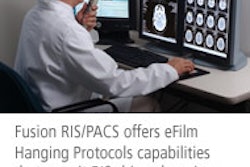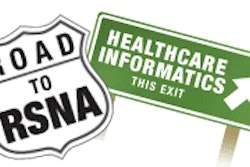ORLANDO, FL - Even partial use of speech recognition can yield significant reductions in report turnaround time, and a majority of clinicians enjoy a standardized, macro-driven report style, according to Dr. Raymond Geis of Fort Collins Radiologic Associates in Fort Collins, CO.
"Even 50% usage of (speech recognition by our radiologists) results in a significant reduction in report turnaround time without sacrificing radiologist productivity," Geis said during a presentation Friday at the annual meeting of the Society for Computer Applications in Radiology (SCAR).
Geis and his study team sought to evaluate clinician PACS use after the addition of partial speech recognition for report generation and the use of a standardized report form for abdomen/pelvis CT studies.
One result often seen from PACS adoption is a dramatic decrease in direct radiologist/clinician interaction, Geis said.
"If we as radiologists want to be involved with clinicians, we have to try to provide our reports as quickly as possible," he said.
Prior to the introduction of speech recognition, the group was producing a 12-hour median turnaround time between study completion and written report availability. Only 25% of clinicians were viewing reports with images, with 73% saying the report was unavailable. The clinicians were viewing 50% of studies within four hours of their completion.
From a literature review, Geis and his team knew that clinicians in an academic setting preferred standardized reports. They also learned that speech recognition decreased radiologist efficiency by 10% to 20%, although the technology is more efficient with use of macros. It also works better for some radiologists and for some types of reporting, Geis said.
The 13 radiologists at Fort Collins Radiology Associates provide reading services for a 240-bed community hospital with one separate outpatient center located four miles away. About 140,000 exams a year are performed, excluding mammography.
Following the adoption of speech recognition, radiologists were able to decide whether to use the technology or not. Fifty percent of reports are now done via speech recognition, Geis said. Even from that limited use, median report turnaround time dropped to four hours, and during the day median report turnaround time was two hours, he noted.
The study team then sent out a questionnaire on PACS and radiology report usage to all 403 active hospital staff. Two sample reports were also presented: one a free-text report and the other a macro-driven report.
Of the 86 respondents, 66% of the clinicians preferred the macro-driven report, commenting they found it easier to read and to find important information, as well as offering better clarity. Twenty-nine percent preferred the free-text report, however, with some sharing concerns that radiologists using "canned" reports will be lax in reporting incidental findings, Geis said.
PACS images were viewed in the hospital by 75% of clinicians, in the office by 73%, at home by 22%, and at other hospitals by 5%. Twenty-four percent of clinicians viewed the study less than an hour after its completion, with 42% looking at the study within one to four hours after completion.
"Two-thirds of the time, they're looking at the image within four hours of completion," Geis said.
Forty-nine percent of clinicians said they always viewed the radiologist's report when they viewed the images, while 22% of clinicians said they reviewed images with reports greater than 75% of the time.
When asked why they view images alone and not with the report, 41% said the report was unavailable, 14% said the report was not helpful, and 5% said they didn't know it was available.
Clinicians said PACS brought increased efficiency and time-savings, with the general consensus of a 10% reduction of the time they spend in the hospital. As for complaints about PACS, clinicians said the biggest problem was that it's still not fast enough, Geis said.
"Despite a four-hour median report turnaround time, when clinicians view images, only 50% of our clinicians are looking at the report at the same time," he said. "And that's still because our reports aren't available quickly enough."
By Erik L. Ridley
AuntMinnie.com staff writer
June 5, 2005
Related Reading
Radiology reports prone to variability, June 3, 2005
Imaging terminology helps distinguish breast tumor types, April 21, 2005
Studies critique radiologists' reports in chest x-ray, knee MRI, April 19, 2005
New tool automates unstructured report analysis, February 18, 2005
Automated report tracking serves clinical, educational goals, January 18, 2005
Copyright © 2005 AuntMinnie.com




















